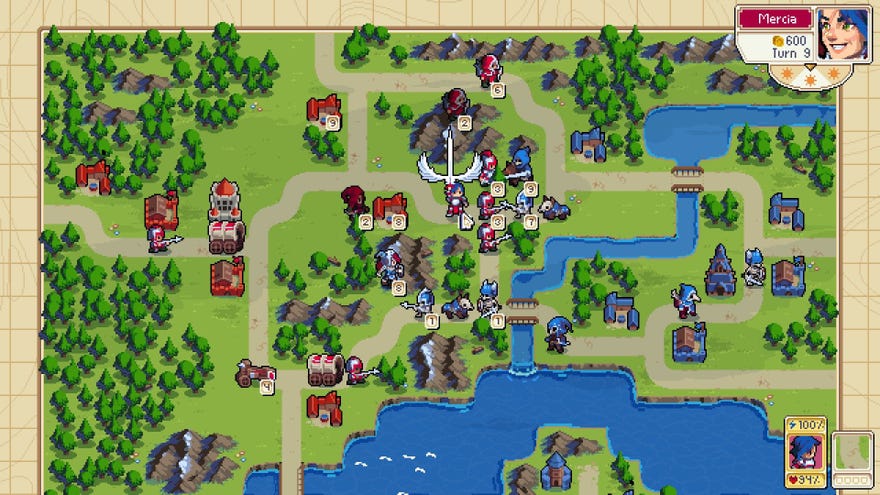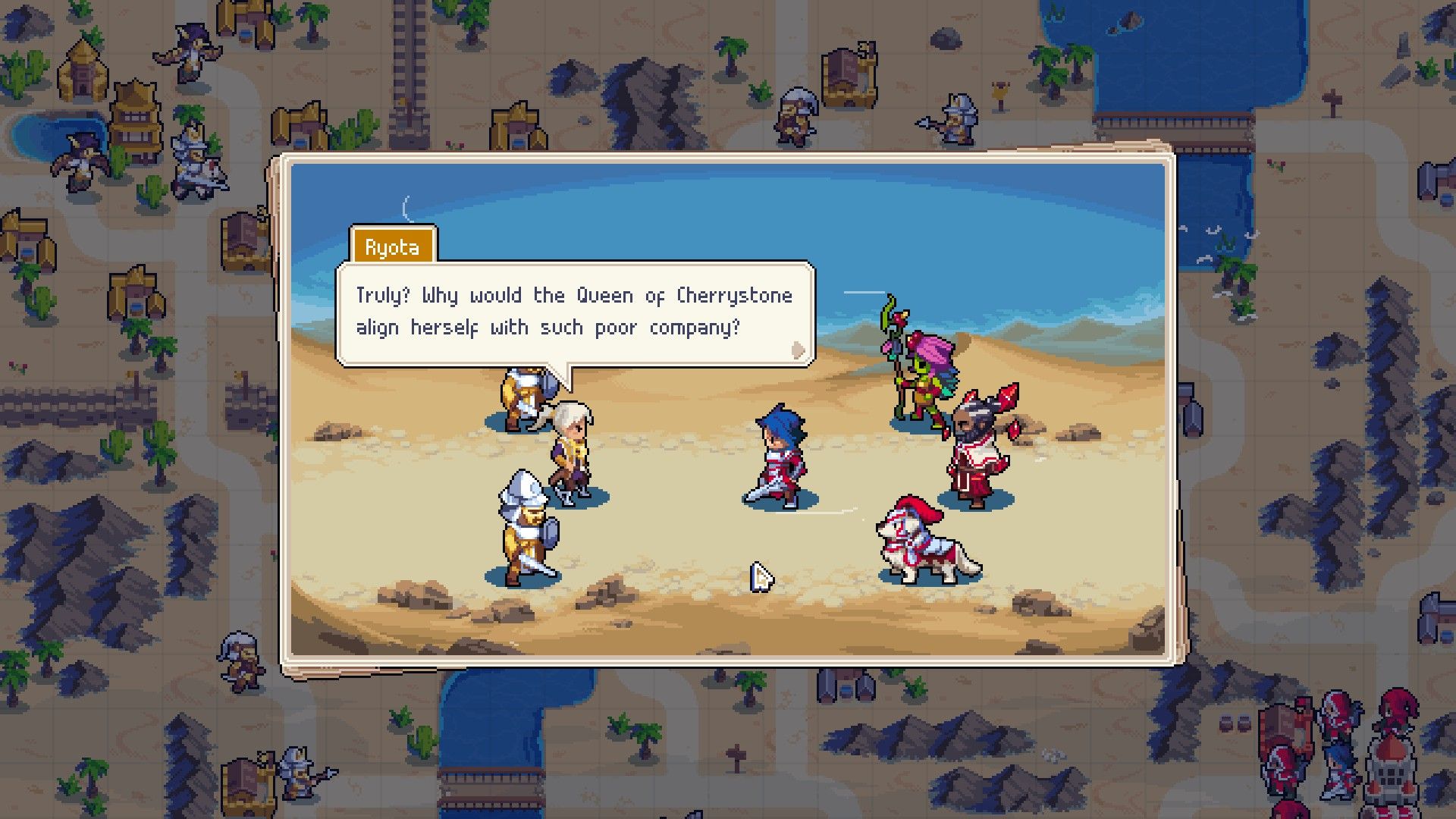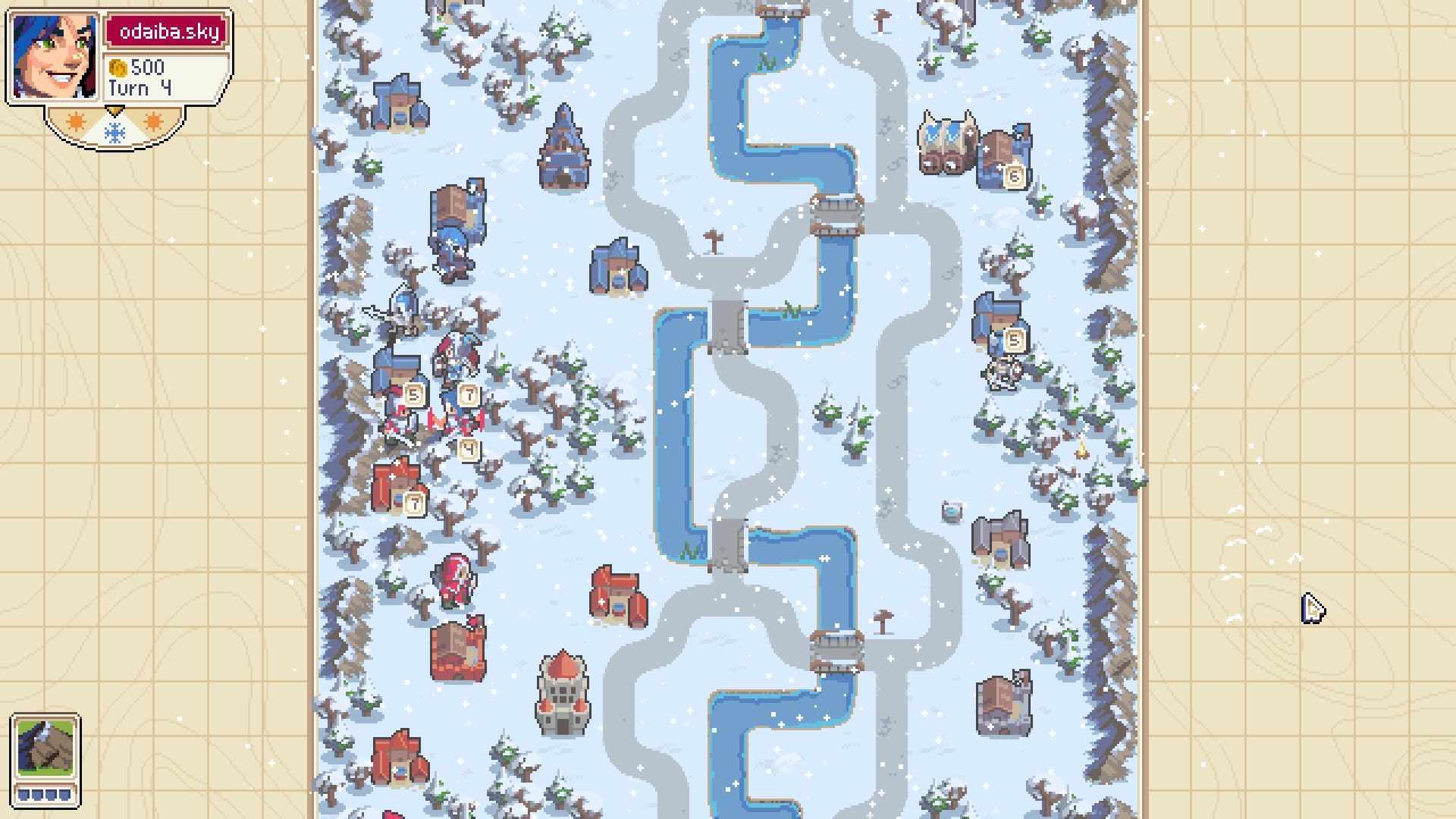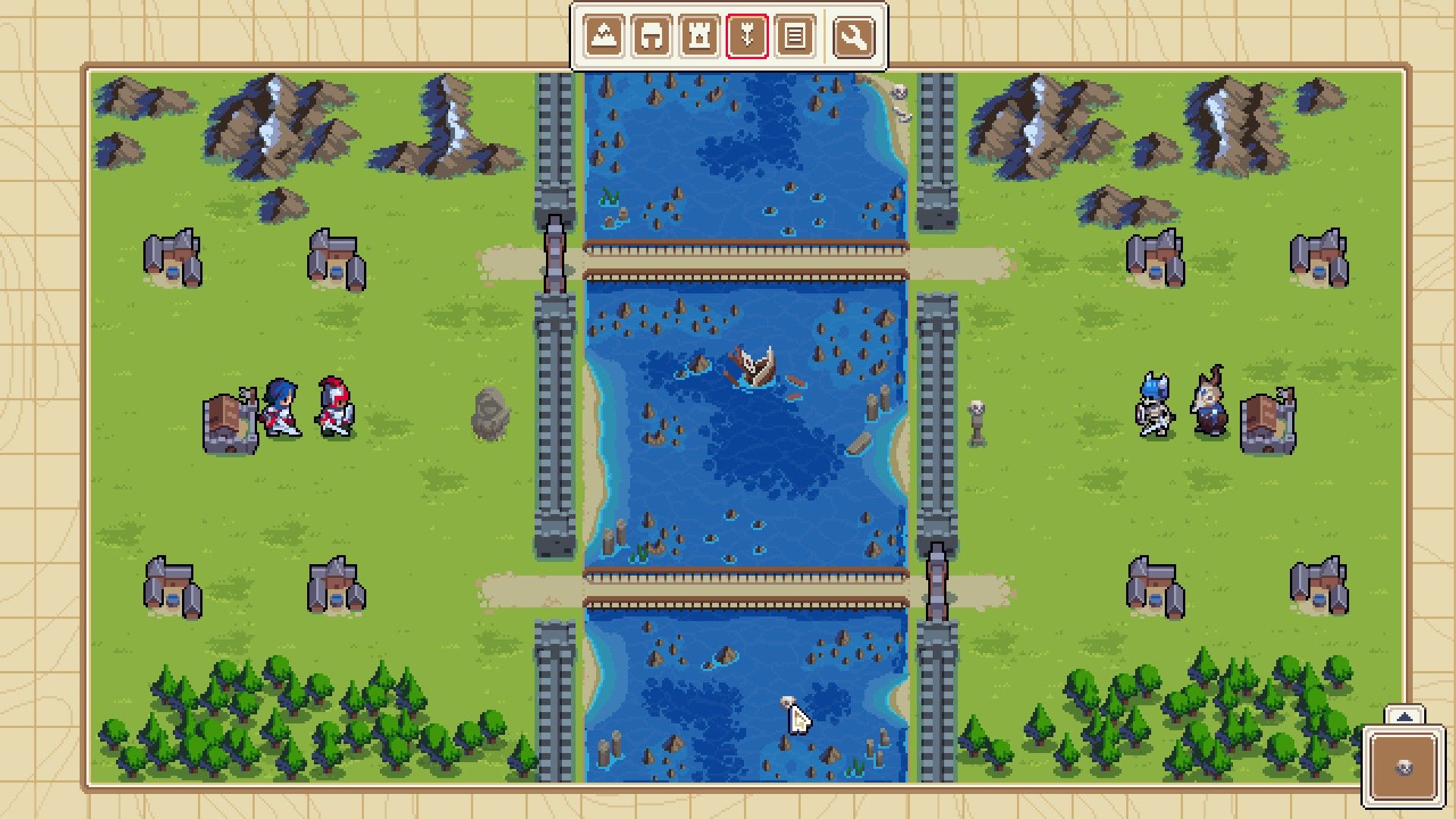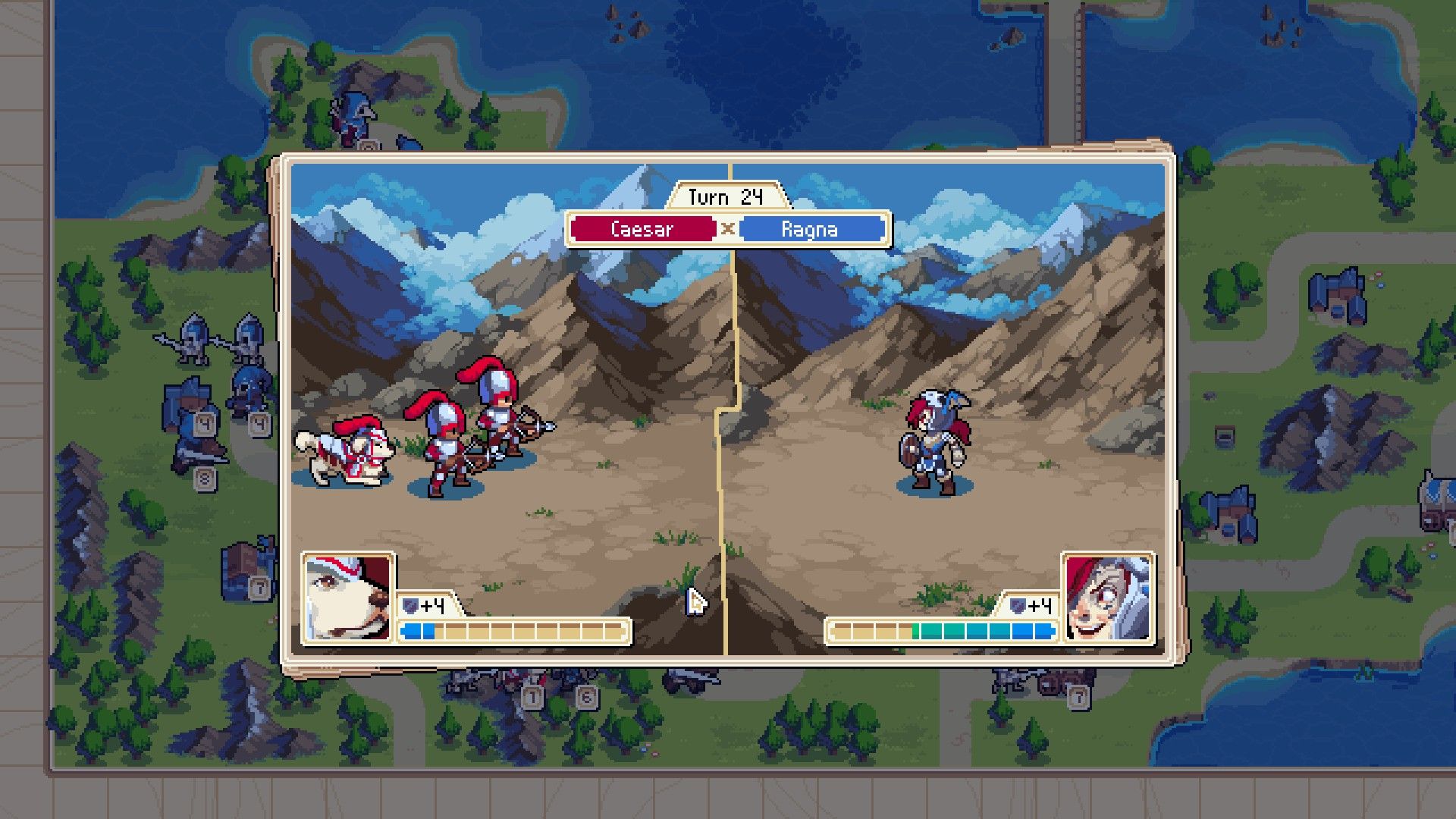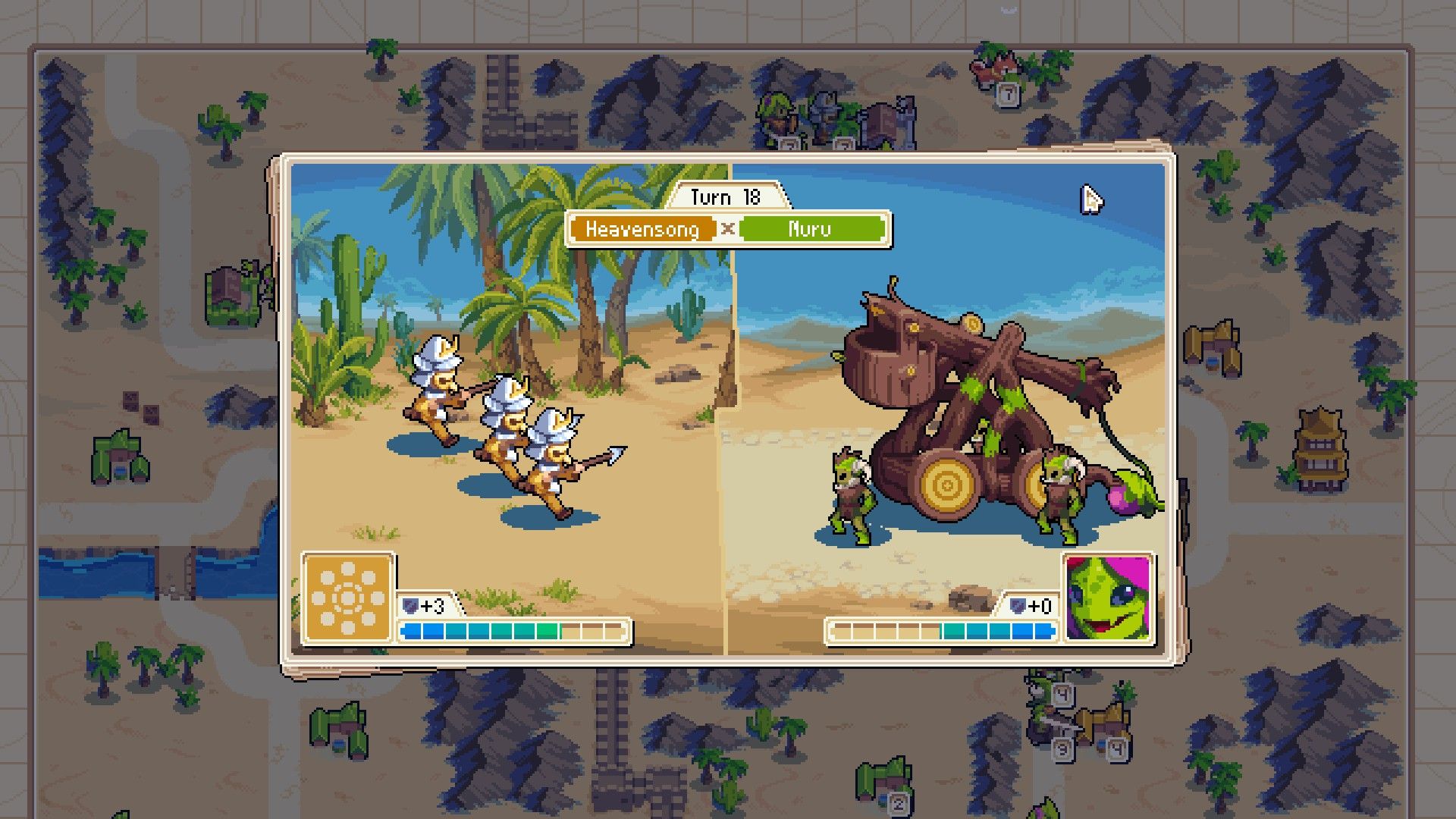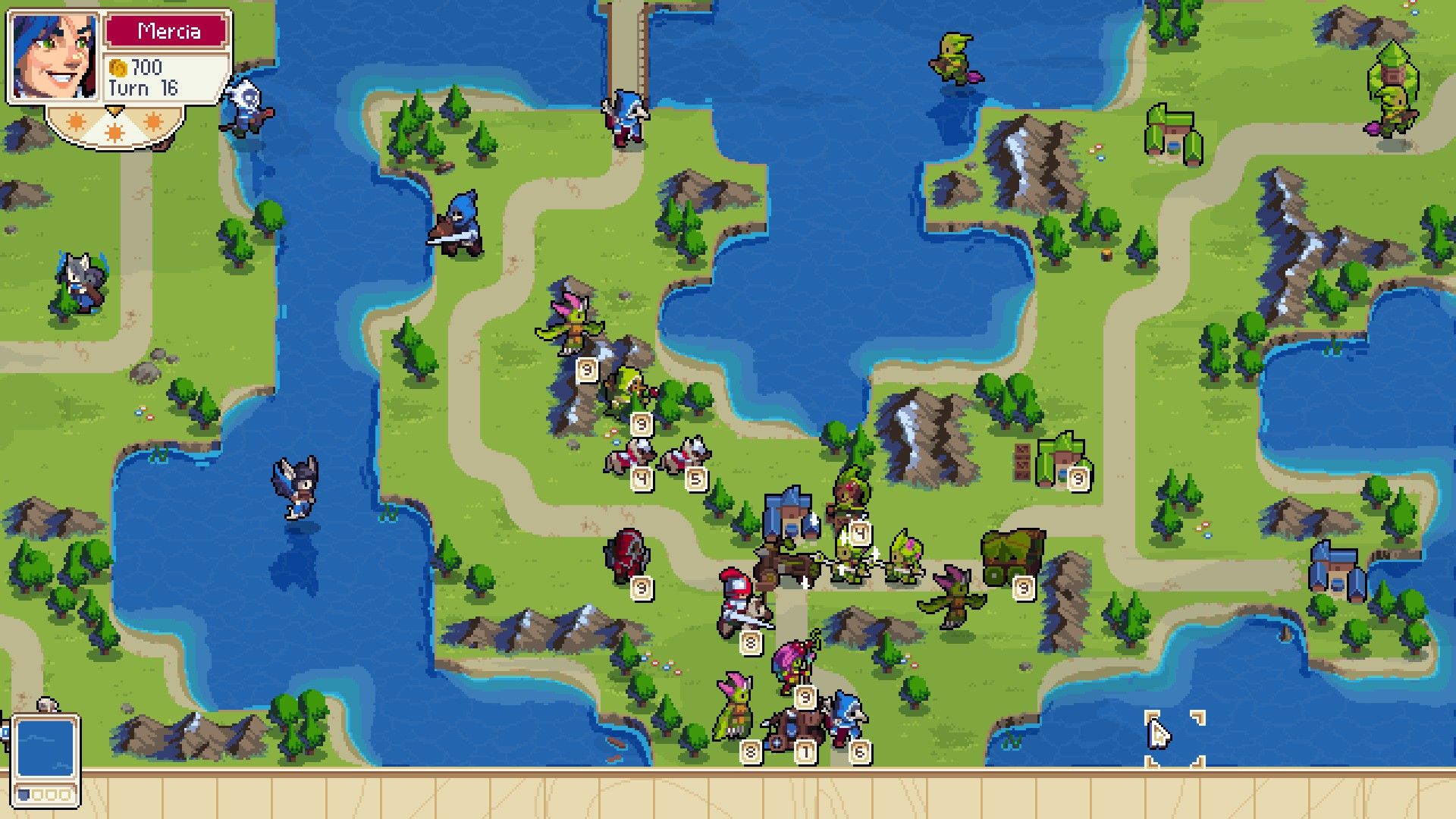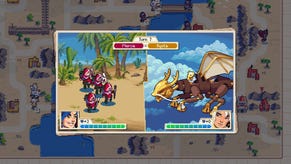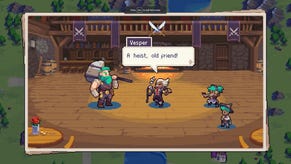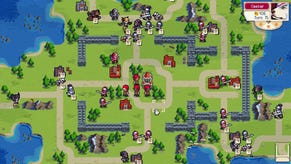Wot I Think: Wargroove
War! Huh! Yeah! What is it groove for?
The pikemen have us surrounded, lads. There are enemy trebuchets to the north, knights to the east, and alchemists to the west. I’ll be frank, men, this is not great optics. Let’s reflect as the battledogs charge in from the south. What could we have done to avoid this? No, I don’t know either.
The battles of turn-based tactical throwback Wargroove can be tough, and often rigged to knock you on your heels. Yet it has reverse-engineered the toy soldiering of Advance Wars to a delightful and slightly unsettling degree. Well, in my book (Brendan’s Big Book Of Battling) that’s mostly a good thing. But it does sometimes mean moments like this, when the pikemen seem destined to kill you.
To describe Wargroove more usefully, it’s a grid-based strategy game about a young Queen called Mercia who is at war with a skeletal army of bad dudes. The campaign sees her royal murderess pottering from battle to battle on a lush world map, each skirmish accompanied with brief flashes of story (short, cartoony dialogues that usually introduce a new baddie or ally). Battles themselves take place on mountain roads, or port towns, or near forts fronted with sand dunes. This is a timesinky war, and some of my battles have lasted a whole hour, which might put some of you off already.
The story sometimes asks for a specific objective (reach the other side of the map alive, for example) but the vanilla goal is to kill the enemy commander or destroy their HQ, a building that stands, proud but fragile, on the other side of the map, like a smug egg. To do that, you’ve got to capture villages for income and pump out troops while playing a sort of militaristic mega-checkers. Move your knights along the road, capture that barracks, get your archers into the mountains for a ranged attack. Hope the pikemen don’t surround you.
Your commander is on the field too, and they’re a strong killer. If they slake their bloodlust by felling other units, they get to use a “groove”. A special move, basically. The Queen can heal her troops in a large radius. Emeric, her advisor, can put down shielding crystals that boost the defence of nearby units. Nuru (an alien who lives among plant people) can teleport a fresh unit right next to herself, provided you’ve got the cash.
Each unit has its own strengths and weaknesses. Pikemen are good at stabbing knights on horseback, alchemists can shoot down witches, giants can bash nearly everything to bits (but not dragons - they turn giants into hot dust). You can also score critical hits in the right circumstances. Dogs will do extra damage to whoever they’re savaging if the unlucky sods are already standing next to another unit of battlepuppers, for example. Meanwhile, harpies will throw extra-sharp knives at their enemies if they do it from above a mountaintop. Anyway, I don’t know why I’m explaining all of this. You’ve played Advance Wars. I know you have. You never stop banging on about it.
But you never talk about the crap bits, do you?
I mean being surrounded by spear boys. As in the Advance Wars games, there are moments in the campaign that feel too tough. Sometimes that’s because the enemy is given a massive starting advantage (lots of troops, lots of buildings), sometimes it’s because enemy troops appear out of nowhere, or zap in from the edge of the screen, all due to some bit of storytelling. The undead are rising from their graves at random, right next to your most vulnerable unit. The bandit forces have summoned multiple giants from off-screen, at the exact spot you just moved away from. Boooo. The worst offender is the fog, which blinds your view of enemy canines or archers, but doesn’t seem to affect your computer foe at all. And one battle is guaranteed to annoy everyone: a dirty fight with bandits who surround your base within a handful of turns and are given an overwhelming amount of units on every side.
It feels unbalanced. You can grit your teeth through these spikes in difficulty, or you can take to the options menu, where you can adjust meters that reduce the amount of damage you take, or result in more gold flushing into your pockets. Those meters are great for accessibility purposes, but when it comes to fights that feel handcrafted in every other way, having to use these meters feels like a cop out. It basically hands you the game and says: "Here, balance it yourself."
This is rubbish. The problem is not money or numbers, just information. Things will happen in the campaign which you can’t know, and they will screw up your plans. A vampire will appear next to your siege engine, a special enemy skill that you haven’t learned about yet will eliminate the cornerstone unit of your eastern forces. These surprises feel annoying, because if you’d only known exactly how many waves were coming, or which enemies would appear, you could have planned ahead. But some missions don’t want to give you that comfort. They force you not to act, but to react.
In the more symmetrical arcade mode, where you play through straightforward missions on well-designed maps, this is much less noticeable, because everything that happens does so within the rules of the game. Arguably, the creators want their story skirmishes to be different, to dramatically swing from one side to the other, as if you are overcoming the odds. And it sometimes works. But too often it feels like these missions, with their story-fuelled reinforcements and unforeseeable assassins, are having their own fun at the expense of your tactics and decisions.
That toughness is odd for something with such a child-like visage. Bright blue skies and cheery pixel pals suggest a strategy game that’s as much for Pokemon trainers as it is for grizzled Advance Wars veterans. Much of the tale is the stuff of a kid’s storybook. But I appreciate the gentle comedy of minor characters. There is a guard who chases cross-country after Queen Mercia with her crown on a cushion. And two soldiers loyal to their commander, who is a dog. They translate for him, Lassie style. Then there are the bandits who speak cogently and with great education about the human systems of bondage and mercantilism that rule over the arable land – land they are currently raiding. I could complain about the simplistic storytelling, the generic “world in peril” fantasy. But if I’m honest, I don’t need much more from Wargroove than for it to have minor outlaws who possess a thorough understanding of pastoral macroeconomics. So, thumbs up.
But then the difficulty peaks and you find all your units sliced down by nightmarish plant people, or bombed from above by vampires. Suddenly what once seemed warm and welcoming is actually just as tough as any fast-paced RTS out there. Tougher even, because in most RTS games, you can quicksave. Here, if you lose a battle on turn 20, the 45 minutes you’ve spent on whatever particularly gruelling mission feels like a goner. It feels like something you don’t want to face again. I’ve busted my 'damage taken' down to 80%, which feels right for me. But it also feels like I’m a grown man wearing stabilisers because I fell off my bike once.
There are other problems. Multiplayer is a bit cumbersome to play with friends. Using a Steam invite wasn’t working when I and Malindy Hetfeld (sometimes of this parish) fought one another over an icy river. So we had to resort to using a code to connect. Hopefully, on release you’ll be able to find a match, friend or no friend, without much difficulty. But it’s not something I’m able to tell you much about, sorry.
The editor stuff, though, is pretty nifty. I made a single map called “Two awful bridges”. But I may as well have drawn the word “stalemate” in giant crayon strokes with the tool that lets you paint roads, and submitted that to the online bank of player maps. It’s a straightforward editor and it rekindles feelings of making garbage Timesplitters 2 maps, whacking down tiles and making terrible deathtraps. For the right player, this will be the best part of the game.
Some of that time-sinkiness could also be blamed on the length of some battle animations. You can skip them by holding right-click for two seconds, which our John points out is frustrating when a “click to skip” would surely do. You can also tweak how often they occur in the options (although again, this feels like a patchy solution). All of this doesn’t annoy me as much as it does John, who we at the office like to call Impatient Baby Boy John. Because he hates to lose units, and doesn’t like to get his little doggy woggies killed in a big battle wattle. I have no such qualms.
But he has a point. This war ‘em up generally drags on in a lot small ways, and the fix-it-yourself solutions in the options are often imperfect. Battles can be sluggish, and when you’ve passed the point in a skirmish when you know you’ve won or lost based on numbers of troops alone, it feels extra slow. Sometimes I found myself wishing the computer would resign. Likewise, I wished there was an “undo” button.
I’m complaining a lot here, but it’s only because all these small nuisances add up. I’m hopeful they’re things that can be fixed in updates, because the piece-moving glee of Advance Wars is alive and well here. And since that’s always been the obvious goal of Wargroove, it’s a success. There is still that sneering smugness to be had in painting the map hot pink. There is still the satisfaction of organising your artillery so that it is both deadly and well-protected. And there’s still a tipping point in most battles. A few turns in which things are exciting, challenging and risky. Do I send the dogs around the flank and gamble losing this bridge? Should I eat the damage from these perilous harpies to give my siege weapons a chance to escape? What can I do to these goddamned pikemen?
To invoke chess would be to take it too far. It is not as precise or succinctly engineered as Into The Breach. It is more chaotic and messy. Sometimes the enemy swordsmen will be left with a sliver of health and block the entire road, screwing up all your plans. Sometimes you’ll have so many enemies to look at, that you won’t notice that dastardly alchemist hiding among them, waiting to take down your dragons. But these are obstacles that you can know about, and it feels good to improvise around your own mistakes (as opposed to the enemy’s sly story tactics). As far as messiness goes, ‘Groove doesn’t have to be precise. This cannon is looser, it can afford to be a bit kooky too.
In summary, it’s good and I like it. And it’s interesting to play a game so enamoured with its inspiration in the same week as I’m wandering through the corridors of Resident Evil 2’s police station again. Hugely different games, sure, but hear me out. Resi is a remake faithful to the spirit of the original but which modernises the old zombie scariness into a present-day survival horror.
Wargroove, on the other hand, is faithful to not just the spirit but the body of its inspiration, keeping both the pleasures and some pains of the old toy war game, pointedly refusing to change most of the basics, and instead simply adding extra layers: online multiplayer, map editing, a “puzzle” mode. It’s not so much a spiritual successor as it is a full-bodied recreation of the franchise, with skeleton horsemen instead of tanks. The impeccable Into The Breach already established itself as the true successor to Advance Wars, but I’m perfectly happy to have the old GameBoy cartridge more or less repackaged, even if some of the old dust is trapped in there with it.
